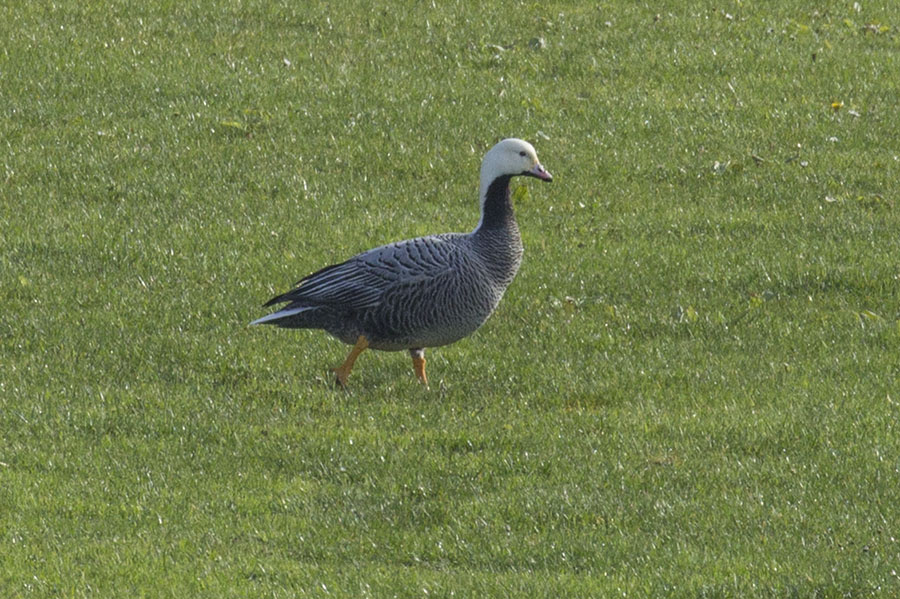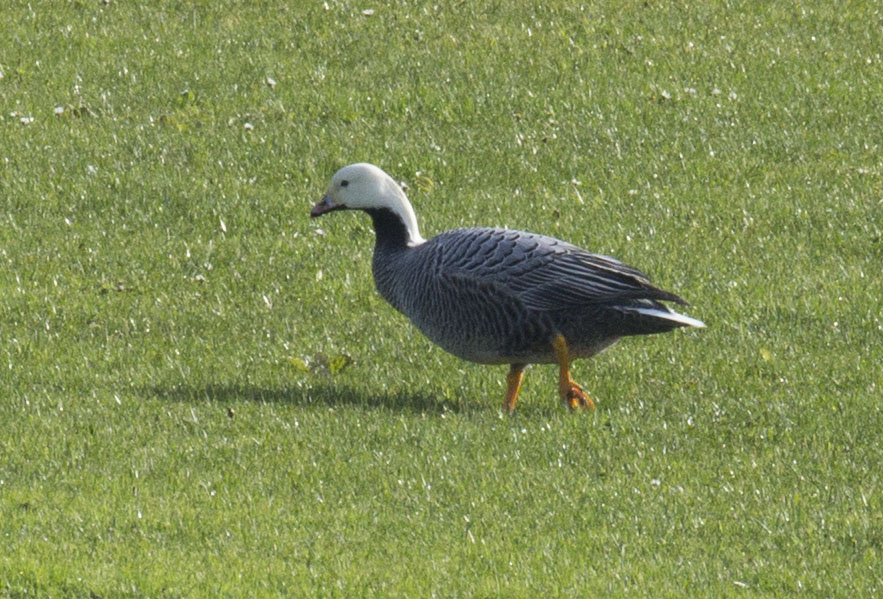by Paul Donahue
Early Monday afternoon (January 23rd) Teresa Wood and I were walking along the berm above Sharp Park Beach in Pacifica. We were participating in the Winter Window Survey of Snowy Plovers. This annual survey, coordinated by the U.S. Fish & Wildlife Service and conducted along beaches from Baja to Washington, is designed to assess the numbers of Snowy Plovers wintering along the Pacific Coast of North America.
Having already walked to the south end of the beach, checking for plovers as we went, we were on our way back north when we paused to look over the golf course and Laguna Salada. With heavy winter rains, parts of the golf course are often flooded, as they are now, and these flooded areas sometimes attract interesting birds. Standing in the water at the edge off one of these flooded areas was a bird about the size of a large gull, and initially that’s what I thought it was. However, as soon as I raised my binoculars I realized it was something very different - an Emperor Goose!
Emperor Goose on the Sharp Park Golf Course - 24 January 2017
Emperor Goose is a quite a special find in Pacifica on a couple of counts. First of all, Emperor Goose is a very beautiful bird, arguably the most attractive of the 13 species of geese known to occur in North America. It is strikingly patterned, with a white head and nape, small, pinkish bill, black throat, scalloped underparts, upperparts that are banded with pale, slaty gray, black, and white, a white tail, and bright yellow-orange legs.
Second of all, Emperor Goose is a rare bird in our area. The species nests around the Bering and Chukchi Seas in the tundra of Alaska and Siberia. Following the breeding season, the species then moves southward only a relatively short distance. According to the Birds of North America Online, “Most of the world's population winters in the Aleutian Islands, with fewer along the south coast of the Alaska Peninsula, Afognak Island, and Kodiak Island…. Very small numbers are present in some winters in British Columbia, Washington, Oregon, and occasionally n. California.”
In our state, according to the California Bird Records Committee, “Emperor Geese turn up about every other year in northern California during fall/winter, and some stay well into spring.” Most California records of the species are from the northern coast, with nearly a third from the Klamath Basin and Central Valley. This Sharp Park bird represents only the second sighting of the species in San Mateo County, with the first being back in 1960 in Pescadero.
On Tuesday many birders showed up along the berm overlooking the golf course with hopes of seeing and photographing the Emperor Goose. They weren’t disappointed. All were delighted as the bird cooperatively grazed in plain view near the shore of Laguna Salada. In the two hours I was there, probably 50 birders and bird photographers made an appearance. Many more people saw and photographed the bird on Wednesday.
When a bird like this Emperor Goose, or the recent Ross’s Gull in Half Moon Bay, shows up in sites way out of their normal range, people usually wonder why. That is often a hard question to answer. Sometimes it is simply because the bird possesses a faulty navigation system and wanders off-course during its migration. Sometimes the bird is blown off-course by a large storm. Sometimes it is forced to travel long distances due to a shortage of food in its normal range. And sometimes there is a combination of all three of these factors at work.
There’s no way to know exactly what brought this Emperor Goose to our shores. Maybe the recent storms played a role. However, with the monumental transformations now taking place in Arctic regions due to climate change, any Arctic bird showing up way out of range, such as this Emperor Goose and the Ross’s Gull, is a potential climate refugee.
According to Alvaro Jaramillo of the San Francisco Bay Bird Observatory, “(this winter) the Arctic has been warm, so much so that freeze-up of sea ice has not occurred in parts of the Arctic. It is not just unusual, but unprecedented. With this in mind. I would say that it is not surprising that this year several Arctic species have shown up where they are unexpected. Most (wildlife) movement in the Arctic tends to be east-west, and I am sure that many birds and other wildlife are moving around up there looking for the right habitat that they expect at this time of year. But some of these birds have decided to head south, essentially looking farther afield given that habitat right now in the north is not as it should be!”
Distressingly many species these days, more all the time, are experiencing significant reductions in their populations. Emperor Goose is among these unfortunate species, and it seems to have experienced a moderately rapid decline in its numbers over its total range. The IUCN (International Union for Conservation of Nature and Natural Resources) maintains the Red List of Threatened Species, tracking the extinction vulnerability of species at risk. On this list, Emperor Goose is included in their “Near Threatened” category. It qualifies for that ranking partly because of the declines in overall numbers that have taken place already, and partly because at least a moderate additional decline in numbers is expected in the future as a result of climate change and the impacts it will have on the species’ Arctic habitat.
Emperor Goose on the Sharp Park Golf Course - 24 January 2017
Like most species of geese, Emperor Geese are primarily grazers. In winter they typically forage in intertidal habitats, where they feed on marine algae, eel grass, and also marine invertebrates (mussels, small clams, etc.). Obviously, the typical habitat and food are very unlike what this wayward goose has encountered on the Sharp Park Golf Course. However, the grassy tundra on which the species feeds during the nesting season does somewhat resemble the golf course, and the Sharp Park goose looked quite content grazing on the grass there.
As long as it is not harassed, the Sharp Park Emperor Goose will likely be fine for as long as it chooses to stay on the golf course. As of this writing, late Wednesday afternoon, the bird was still present. While it is no guarantee, most Emperor Geese that reach California over-winter in the state, but fly north again in spring. Hopefully this bird will hang around at least long enough for those who care to get a glimpse of it.
The appearance of this beautiful goose at Sharp Park underlines the importance of habitat such as Laguna Salada to wildlife. Undoubtedly, if the lagoon and its associated wetlands are protected, wildlife will continue to be drawn to the area. Even better for wildlife would be if the lagoon were allowed to revert to a more natural condition.
To be in the loop about sightings of rare birds in San Mateo county, and to learn about our local birds, please consider joining Sequoia Audubon Society, the Audubon chapter in San Mateo county. The organization sponsors field trips nearly every weekend, and most are free… http://www.sequoia-audubon.org/fieldtrips.html
Paul Donahue
Pacifica, California
25 January 2017

